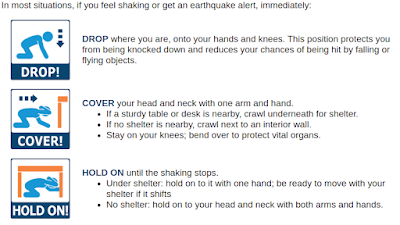#17,725
The third Thursday in October (this year, Oct 19th) is International Shakeout Day, when dozens of American states and many countries around the world practice earthquake safety. From the Shakeout.org website:
This year's International ShakeOut Day is October 19, when millions of people worldwide will participate in earthquake drills at work, school, or home!
At 10:19 a.m. (local time) on 10/19, you can join millions of people across the world practicing earthquake safety.
While we encourage participation with everyone, you can register your ShakeOut drill for any day of the year, and drill at a time of your choice. You can also include people in multiple locations through video conferencing.
Last month's unexpected earthquake in Morocco, which killed and injured thousands, is a reminder that big quakes can strike even in low-probability zones (see global risk map below).
Since then, populations have changed and/or shifted and ongoing research has uncovered new seismic risks (see USGS: Updated U.S. Seismic Risk Hazard Maps), providing geologists with a better understanding of the extent of ground shaking from these quakes.
A study, published in 2015 in the journal Earthquake Spectra, nearly doubled – to 143 million - the number of Americans who live or work in areas susceptible to potentially damaging ground shaking.
The New Madrid Seismic Zone (NMSZ), the Pacific Northwest (Cascadia fault), coastal South Carolina and even New York City and parts of New England are at risk of seeing significant seismic activity.
Earthquakes aren't the only seismic hazard in the United States, as there are nearly a dozen `very high risk' volcanoes in the continental US (4 in Washington, 4 in Oregon & 3 in California), along dozens of `lesser' threats. While earthquake damage is generally localized, volcanic eruptions can affect property and populations thousands of miles away.
When you add in that the Gulf and Atlantic coastlines are susceptible to tsunamis generated from distant earthquakes (see East Coast Tsunami Threats), then there is better than a 50-50 chance that you live in an area that is at risk of some seismically induced disaster.
While we can't prevent the next big quake from happening, we can prepare for it.
Working to improve earthquake awareness, preparation, and safety is Shakeout.org, which promotes yearly earthquake drills and education around the country (see A Whole Lotta Shakeouts Going On).
If you live in, work in, or ever plan to visit a seismically active area, I strongly would urge you, your family, and your employees take part in these yearly drills.
After the shaking stops, you'll have to find ways to cope with the aftermath.
While the government will send help, you could find yourself pretty much on your own for several days and living in less than comfortable conditions for weeks.
For starters - and as a bare minimum - every household should have a disaster plan, a good first aid kit (and the knowledge to use it), an emergency battery operated NWS weather radio, and emergency supplies to last a minimum of 72 hours during a disaster.
While 72 hours is an admirable start, I wouldn't feel comfortable stopping there. Here in the United States many agencies and organizations recommend that households work towards having a 10-to-14 day supply of food, water, and emergency supplies on hand.
For more on earthquake preparedness, both here in the United States, and around the world, you may wish to revisit:





